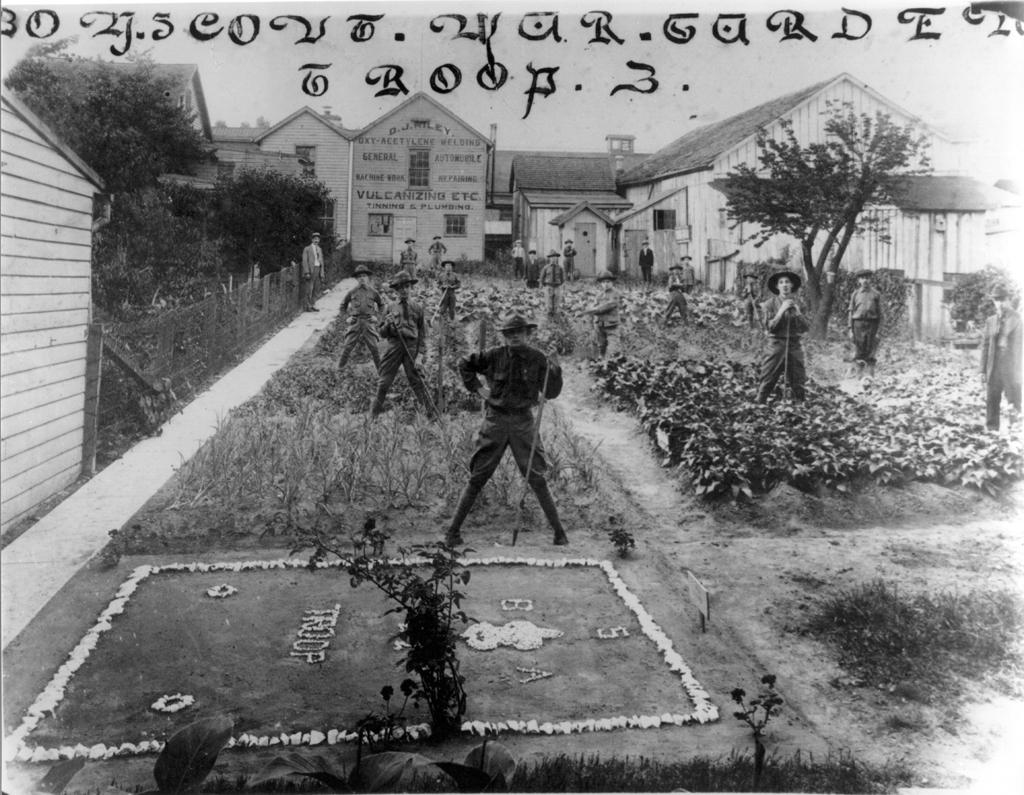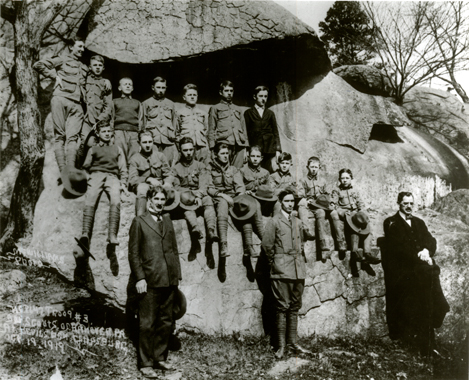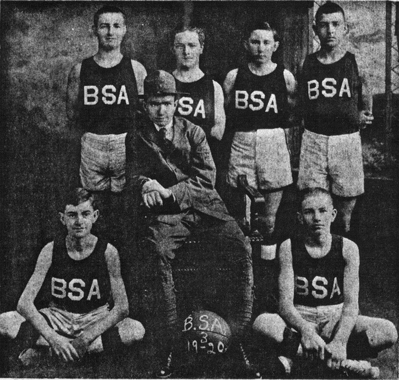Charter is Granted on June 20, 1918
On June 20, 1918, Troop 3, sponsored by St. Joseph Church in Hanover, was granted a charter by the Boy Scouts of America, with Reverend G. W. Nicely serving as the commissioner representing the local council on the charter. At that time, Hanover had a population of around 8,000 people. Thomas L. Murphy was the first leader of the Troop, having previously supervised a group of young people in the local Boys Club. He received assistance from James B. Baker and Ralph H. Storm. In 1919, James B. Baker took over as Scoutmaster, succeeding Thomas L. Murphy. The early Troop was supported by Reverend James A. Huber, Frank Brenner, and Stanley Scheivert, who served as committee members.
1918 Boy Scout War Garden: Troop 3
 Pictured is Boy Scout Troop 3 (now Troop 103) of Saint Joseph Catholic Church in their victory garden in 1918 at the rear of the former Knights of Columbus Council 871 building on York Street, Hanover.
Pictured is Boy Scout Troop 3 (now Troop 103) of Saint Joseph Catholic Church in their victory garden in 1918 at the rear of the former Knights of Columbus Council 871 building on York Street, Hanover.
Mr. Thomas Murphy was the Scoutmaster (standing on walk) and James B. Baker was the Assistant Scoutmaster (dark suit, right rear). Others in the photo are Francis Kuhn, John Kinneman, Paul Hertz {two prong hoe), Earl Hertz {last man in left row), Joe Aumon, Nicholas Murphy, John Aumon {front of sign with hoe), Jacob Landis {legs together), Ernest Norwig {back of Landis), Arthur Kelly {dark suit on right), Harold Brady {light shirt). A few of the members are unknown.
Original Members
Troop 3’s original charter consisted of 23 Scouts: Richard Alleman, Charles Brady, Roger Britcher, Guy Gotwalt, Charles Hufnagle, Roger Johnson, Arthur Kelly, John King, John Kinneman, David Klunk, Robert Klunk, Francis Kuhn Jr., Jacob Landis, Lowell Lingg, Romanus Lingg, Charles Maxwell, John Miller, Nicholas Murphy, Norbert Neiderer, William Overbaugh, Gerald Pfaff, Thomas Smith, and Joseph Urick. An additional 14 boys, including John Aumon, Joseph Aumon, Harold Brady, Bernard Brenner, Francis Devine, Paul Hertz, Thomas Johnson, Samuel Mattingly, Ernest Norwig, A. Pentz, Henry Smith, Edgar Sneeringer, James Staub, and Austin Storm, joined within the first year. The Scouts held their meetings in various locations, starting in John McKinney’s barn and moving to the garage of Ambrose Klunk, the Knights of Columbus Hall, and finally to St. Joseph Hall.
The Troop’s main objective was community service, and one of their first activities was planning a large war garden behind the former Knights of Columbus building on York Street during World War I. They also participated in the sale of liberty war bonds. In 1920, Troop 3 formed their own basketball team with Scoutmaster James B. Baker as the coach. The team members included Scouts Guy Gotwalt, John Kinneman, Jacob Landis, Paul Hertz, Francis Kuhn, and John Aumon.
1919 at Devils Den, Gettysburg
 Pictured is Boy Scout Troop 3 (now 103) of Saint Joseph’s Catholic Church at Devils Den in Gettysburg on October 19, 1919.
Pictured is Boy Scout Troop 3 (now 103) of Saint Joseph’s Catholic Church at Devils Den in Gettysburg on October 19, 1919.
Scouts in the top row (left to right) are Nicholas Murphy, Joseph Urick, Charles Maxwell, Francis Kuhn Jr. Paul Hertz, Joseph Aumon and Myers (?). The scouts in the middle row (left to right) are Roger Johnson, Jacob Landis, John Aumon, Charles Hufnagle, John Kinneman, Norbert Neiderer, Robert H. Pentz, and Ernest Norwig. In the bottom row (left to right) are Thomas Murphy, Scoutmaster James Baker and an unknown person.
The 1920 Troop 3 Basketball Team
 In 1920, Troop 3 had their own basketball team with Scoutmaster James B. Baker as their coach.
In 1920, Troop 3 had their own basketball team with Scoutmaster James B. Baker as their coach.
The Conewago Council was organized as a Second-Class council during the summer of 1919. The local council included Scouts from Hanover, Littlestown, New Oxford, Abbottstown and East Berlin. St. Joseph Boy Scouts became known as Troop 103 after the Conewago Council merged with the York-Adams Council in 1931. In July 2002, the York-Adams Area Council was restructured from four to three Districts. At that time, Troop 103 resided was in the Blue and Grey District until 2011 and now resides within the boundaries of the Battlefield District. On February 25, 2010 the York-Adams Area Council agreed to merge with Keystone Council and was named on April 1, 2010 as Keystone York-Adams Council. On October 1, 2010 the council was formally named New Birth of Freedom Council.
Players sitting from left to right are Guy Gotwalt and John Kinneman Players Standing from left to right are Jacob Landis, Paul Hertz, Francis Kuhn and John Aumon.
Scout Troop 103 Celebrates 100 years – June 16, 2018
 With 145 guests in attendance, Boy Scout Troop 103 of St. Joseph Catholic Church, Hanover, celebrated its 100th anniversary on June 16, at the parish’s social hall.
With 145 guests in attendance, Boy Scout Troop 103 of St. Joseph Catholic Church, Hanover, celebrated its 100th anniversary on June 16, at the parish’s social hall.
Click here to read more about the event.
Local Council History
The Conewago Council was established as a Second-Class council in the summer of 1919, with Scouts from Hanover, Littlestown, New Oxford, Abbottstown, and East Berlin. St. Joseph Boy Scouts, which was part of the Conewago Council, later became Troop 103 after merging with the York-Adams Council in 1931. At that time, Troop 103 was based in the Conewago District. However, in July 2002, the York-Adams Area Council underwent a restructuring, resulting in the consolidation of four districts into three. Troop 103 subsequently resided in the Blue and Grey District until 2011. On February 25, 2010, the York-Adams Area Council agreed to merge with Keystone Council, and the resulting organization was named Keystone York-Adams Council on April 1, 2010. On October 1, 2010, the council was renamed the New Birth of Freedom Council, within whose boundaries Troop 103 currently resides, specifically in the Battlefield District.
National Council
The Boy Scouts of America is an organization owned by the National Council, incorporated on February 8, 1910, and chartered by Congress in 1916. It provides an educational program for boys and young adults, modeled after the Scouting movement founded by Lord Robert S. S. Baden-Powell in England in 1908. The National Executive Board, a volunteer board of directors, leads the National Council, while a staff of professional Scouters performs administration. The corporation aims to promote the ability of boys to do things for themselves and others, teach them patriotism, courage, self-reliance, and other virtues through Scoutcraft, and cooperate with other agencies.
The Boy Scouts of America’s mission is to serve others by instilling values in young people, preparing them to make ethical choices, and achieve their full potential. The values the organization strives to instill are based on the Boy Scout Oath and Law.







